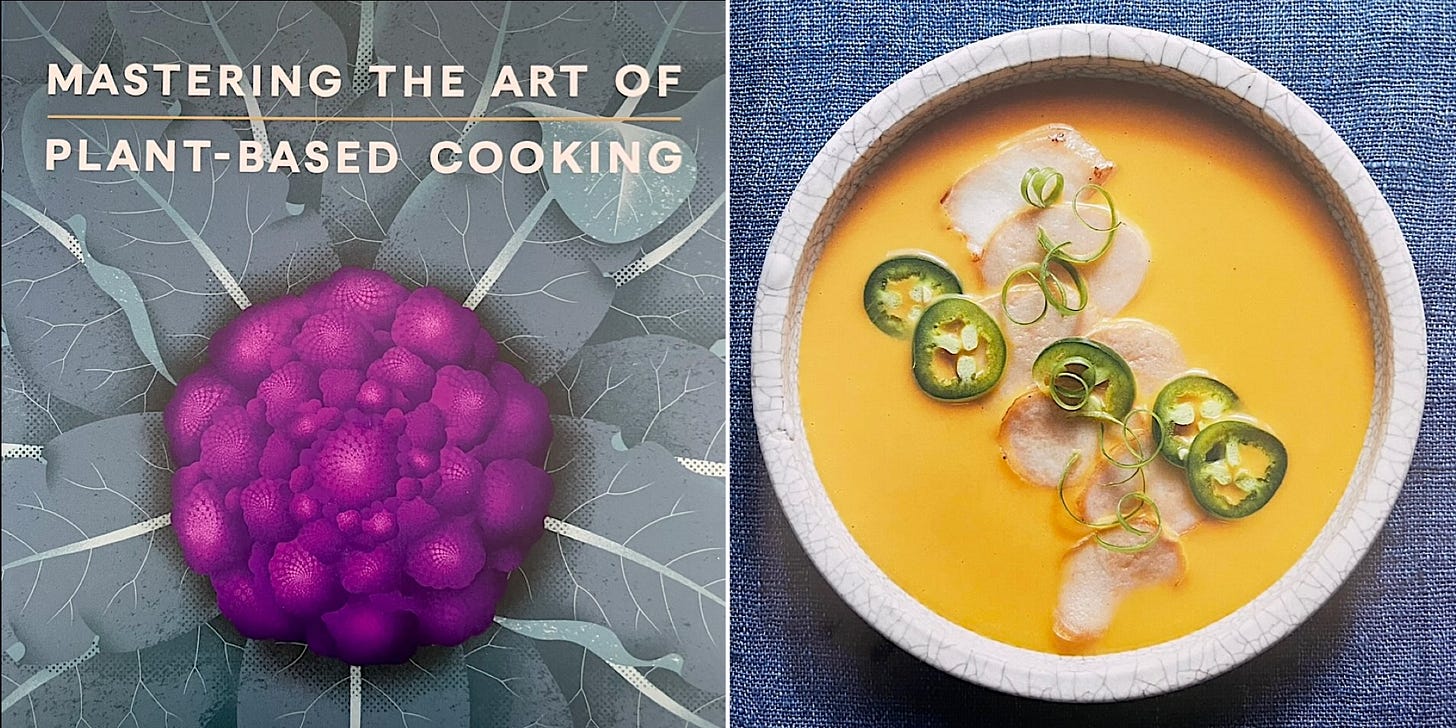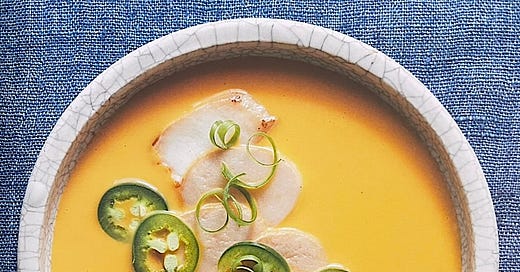When Joe Yonan asked me to contribute recipes to his cookbook Mastering the Art of Plant-Based Cooking, I thought about how the food cultures of Lima and Tokyo are connected by the Pacific Ocean.
Trumpet Mushroom Tiradito

Tiradito, the marriage of Peruvian ceviche and Japanese sashimi, is one of the hallmark dishes of the Nikkei cuisine that Japanese indentured workers and immigrants first cooked in early twentieth-century Lima. Though there are many variations, three important ingredients are salt, hot pepper, and citrus-all of which are combined with ginger and jalapeño in the leche de tigre, the spicy marinade that captures the essence of both ceviche and tiradito.
Unlike ceviche, tiradito is traditionally sliced and sauced rather than "cooked" in the marinade. In food writer Nico Vera's version, inspired by his travels to Lima and Tokyo, a kombu stock imparts umami from the sea, a sweet potato mash balances and thickens the leche de tigre, and sliced trumpet mushroom stems resemble sashimi. This makes for a beautiful, elegant dinner-party course and is best enjoyed immediately after preparing. In the Peruvian tradition, serve extra leche de tigre in shot glasses and drink with an optional splash of pisco.
Makes 4 servings
Time: Weekend
Storage: Not recommended. The extra kombu stock and sweet potato can be refrigerated for up to 1 week or frozen for up to 3 months.
4 large trumpet mushrooms (9 ounces/255g total), with stems 3 inches (7.5cm) long and 1 inch (2.5cm) thick
1 (4 x 6-inch/10cm x 15cm) piece dried kombu, rinsed
2 cups (470ml) water
¼ teaspoon fine sea salt, plus more to taste
1 small garnet sweet potato (7 ounces/200g)
3 teaspoons toasted sesame oil
¼ cup (60ml) fresh lime juice, plus more to taste
3 tablespoons chopped red onion
3 tablespoons chopped celery
1 tablespoon chopped fresh cilantro leaves
1 tablespoon chopped peeled fresh ginger
2 medium garlic cloves, chopped
1 tablespoon chopped seeded jalapeño, plus more to taste and thin slices for garnish
1 scallion, thinly sliced, for garnish
Starting with the stem end, slice each mushroom on the diagonal into ¼-inch (3mm) slices, including the mushroom cap.
In a medium pot, combine the kombu, water, and salt and let the kombu soak for 15 minutes. Bring to a boil over high heat, then reduce to a simmer and cook for 15 minutes, stirring initially to dissolve the salt. Turm off the heat. Remove the kombu and compost it. Add the mushroom slices to the pot with the kombu stock and let cool to room temperature, about 1 hour.
Meanwhile, in another medium pot. combine the sweet potato with enough water to cover by 1 inch (2.5cm).
Bring the water to a boil over high heat, then reduce to a simmer and cook until the sweet potato is fork-tender, 20 to 30 minutes. Drain. When the sweet potato is cool enough to handle, peel it and mash enough of the flesh to equal ¼ cup (62g). (Compost the peel and reserve the extra sweet potato for another use, such as adding to soups, smoothies, tacos, and grain bowls.)
Remove the mushroom slices from the kombu stock and pat dry with a towel. Measure ½ cup (120ml) kombu stock for the leche de tigre and reserve the remaining stock for another use, such as adding to soups and sauces.
In a large nonstick skillet, heat 2 teaspoons of the sesame oil over medium heat until it shimmers. Add the mushroom slices and cook undisturbed on one side until the edges are lightly golden, about 1 minute.
To make the leche de tigre, in a blender, combine the reserved ¼ cup (62g) sweet potato mash, ½ cup (120ml) kombu stock, the lime juice, onion, celery, cilantro, ginger, garlic, jalapeño, and the remaining 1 teaspoon sesame oil and puree on high until smooth, about 30 seconds. Taste and season with salt, more lime, and/or jalapeño as needed. Transfer ½ cup (120ml) leche de tigre into a container with a spout.
Set aside the remaining leche de tigre.
Slowly pour the ½ cup of leche de tigre onto the center of each of four small plates to form a circular pool, 2 tablespoons per plate. Arrange the mushroom slices over the pools, garnish with the sliced jalapeno and scallion, and serve immediately with the reserved leche de tigre in shot glasses (with an optional splash of pisco).




its stunning, intriguing and I would love to try this!
Nico proving (again) that plant-based cooking is exciting on every level...